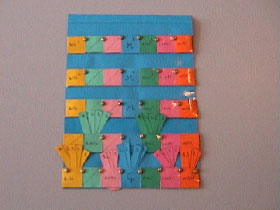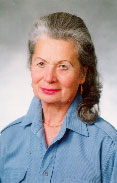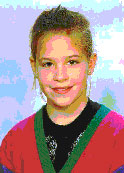- The problem
solved: A novel supplementary
tool for teaching the conversion between everyday units of
measurement.
-
Definition:
A playful, simple
teaching device (made of paper, plastic, textile, wood, metal, etc., in any
suitable size) which facilitates and greatly simplifies the teaching,
learning and practicing of unit conversions.
- Presentation: The prototype is preferably a wheel of 21 cm diameter, made of cardboard and divided into 7 concentric circles and 8 identical sectors. Each sector represents a digit. All circles have different colours. The outermost circle depicts the chosen metric unit for a given measure. The middle of the wheel represents the chosen unit, to the right of which we find the prefixes in decreasing order (centi, deci, milli), and to the left those in increasing order (deca, hecto, kilo). The Latin name of a prefix is also depicted in the national language together with its meaning. For example, centi in Hungarian: “tized”; numerical meaning as a ratio: 1/10, as a decimal ratio: 0.1, as a power: 10-1.
In the centre of the wheel there is a black and a coloured pointer that can be rotated along the wheel. The unit to be converted is always represented in black, while the unit we are looking for is depicted in colour. The wheel also comes with 10 small cardboard objects numbered from 0 to 9; these may be of any suitable shape depending on the targeted age group.
A given sector represents a metric unit, i.e., a digit, but this can contain only nine numbers (ten if we also include zero). If the number to be converted has two digits, we must “roll” into the neighboring sector. Rolling in the higher-to-lower direction or in the lower-to-higher direction means a sector-wise multiplication or division, respectively, by a factor of ten. A sector labeled with a dot also represents a digit to count with, but is not used in everyday practice (e.g., 10 kg is not a “decakilogram” or 100 metres is not a “hectometer”).

-
Application:
In any learning
community or individually.
-
Advantages: cheap, can be
fabricated from many types of material (paper, plastic, leather, textile,
wood) in different sizes, can be carried in a pocket or placed on a wall or
an excercize book for systematic practice.
-
Stage of development:
the prototype is
ready, 3000 promotional pieces are in press.
- Available documentation: patent documentation with drawings
2. The inventor:


-
Name: Szántay,
Judit and Szántay, Georgina
- Introduction: I am a retired chemistry teacher (Judit Szántay) who had graduated from the Technical University of Budapest. Together with my granddaughter, Georgina, who goes to secondary school, we have for many years been making supplementary learning tools for almost every subject. This hopper became so popular among her classmates and some teachers, that we thought it should be made known and distributed on a larger scale.
3. The protection:
- Form: Patent application
- Priority:
- Countries:
- Owner of patent: The inventors
4. Business purpose: product sale
5. Contact:
- Name: Szántay, Judit
- E-mail: cs.szantay@chello.hu
- Fax:
- Telephone: +36 1 466 2042
- Address: H-1113 Budapest, Zsombolyai u. 8.